Patriot Viper III Review: 2x4 GB at DDR3-2400 C10-12-12 1.65 V
by Ian Cutress on November 18, 2013 1:00 PM EST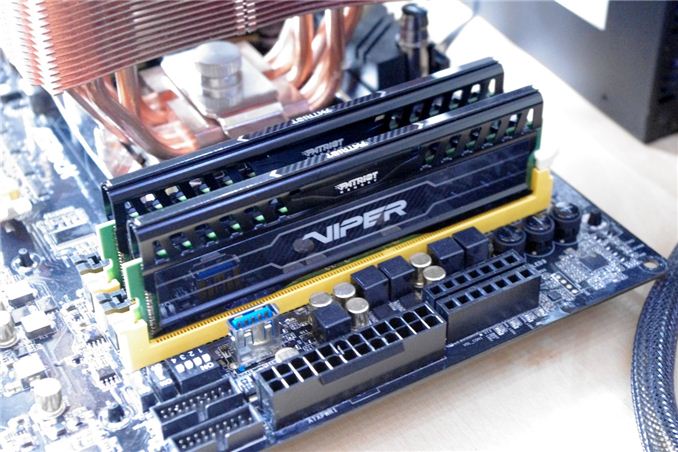
Perhaps I am out of the loop, but in recent CPU generations of PC building, Patriot Memory has not featured much on my radar. A quick look at their product range tells a tale: the fastest DDR3 kits are 2400 MHz, and by comparison to some other memory manufacturers, their presence at Computex was somewhat discreet. Nevertheless, when I got in contact for our series of quick fire Haswell memory reviews, Patriot were keen to sample a couple of their 2x4 GB Viper III kits of DDR3-2400 C10 1.65V.
Patriot Viper III 2x4 GB DDR3-2400 C10 Overview
With mainstream computing platforms all focused on dual channel memory, we are still in the realm where two sticks of DRAM in a kit is the norm. Modern OSes are eating varying amounts of memory, and the more computing power people have access to, the ‘lazier’ programmers and users can be with their memory allocation. For casual desktop users on a Windows based platform, 4 GB can easily be enough: gamers and power users can look at 8 GB and be happy, while power users/enthusiasts/multi-GPU gamers will desire a 16 GB kit minimum. Only specific niche targets will aim for more, for which there are still a numerate selection of choices to consider.
But for most builders, an 8 GB kit still hits a nice balance between ‘enough memory’ and cost. The kit Patriot have sent us for review is not actually on Newegg right now – the nearest to the PV38G240C0K model is actually the PV38G240C1K variant, a 2400 C11 kit, which retails for $92. On Amazon.com the PV38G240C0K kit is actually $117, although on NCIX it retails for CAD$100. Because Patriot sent us two 2400 C10 kits to test, we tested a kit as it comes and both kits together, although this is not a recommended scenario (see later).
In terms of overclocking, this memory kit starts with an initial Performance Index of 240, and with nothing more than a small bump in voltage and a memory strap adjustment, we see 2666 10-12-12, giving a PI of 267. Adjusting through various CL values confirmed that a PI of 267 is the best result for a 24/7 stable system, valid up to 2666 C10. Beyond C10 the system refused to be stable above 2666 MHz, thus lowering the PI.
Specifications
| ADATA | Corsair | Patriot | ADATA | G.Skill | ||
| Speed | 1600 | 2400 | 2400 | 2400 | 2800 | 3000 |
| ST | 9-11-9-27 | 11-13-13-35 | 10-12-12-31 | 10-12-12-31 | 12-14-14-36 | 12-14-14-35 |
|
Price (at review) |
- | $200 | - | $117 | $316 | $520 |
| XMP | - | Yes | Yes | Yes | Yes | Yes |
| Size | 2 x 8GB | 2 x 8GB | 2 x 8GB | 2 x 4GB | 2 x 8GB | 2 x 4GB |
| PI | 178 | 218 | 240 | 240 | 233 | 250 |
|
|
||||||
| MHz | 1600 | 2400 | 2400 | 2400 | 2800 | 3000 |
| Voltage | 1.35 V | 1.65 V | 1.65 V | 1.65 V | 1.65 V | 1.65 V |
| tCL | 9 | 11 | 10 | 10 | 12 | 12 |
| tRD | 11 | 13 | 12 | 12 | 14 | 14 |
| tRP | 9 | 13 | 12 | 12 | 14 | 14 |
| tRAS | 27 | 35 | 31 | 31 | 36 | 31 |
| tRC | 46 | 43 | 49 | |||
| tWR | 20 | 16 | 16 | |||
| tRRD | 315 | 301 | 391 | |||
| tRFC | 6 | 7 | 7 | |||
| tWTR | 10 | 10 | 12 | |||
| tRTP | 10 | 10 | 12 | |||
| tFAW | 33 | 26 | 29 | |||
| CR | 2 | 3 | 2 | |||
Compared to the ADATA 2400 C11 we reviewed last time, most of the secondary sub-timings are smaller (tRC, tWR, tRRD, tFAW) - some of this will be due to the lower density (2x4 GB vs 2x8GB) memory. The amazing thing is that our XMP detection showed a command rate of 3T for the Patriot memory, although this was reported as 2T in the operating system.
Visual Inspection
In terms of the kits we have in to test, Patriot and Corsair are doing similar packaging paradigms: a cardboard outer shell that is sealed, and an easy to open plastic insert to hold the memory stable in transit.
The heatsink extends an extra 12mm (0.47 inches) above the memory PCB, giving a total heatsink height of 36mm.
Buying the Correct Memory Kit
For this review, we have done two sets of numbers: one with one kit of the Patriot 2400 C10 memory, and another with two kits put in the same system. Despite this testing, it is not a recommended scenario: do not buy two memory kits, even if they are the same model, and expect them to work together. There are many, many forum posts with users having two of the same memory kits in a system and it not working. I have even been a victim at one point to this scenario.
There are several factors at work:
- When you buy a memory kit, it is not only designed to work at the rated speed, but in the rated configuration only. There is no guarantee it will work in a larger memory configuration.
- While each memory kit may be labelled the same, they can be different, especially when it comes to overclocking.
- More often than not, memory timings are very aggressive, meaning for two kits to work together, memory timings have to be weakened.
- The only time it will work is if the two memory kits have lots of overhead, and if the CPU memory controller can handle it.
Rule of thumb: if you want 16GB/32GB/64GB of memory, buy a 16GB/32GB/64GB kit. If it works out it costs more, that is because the kit is fully validated in that configuration.


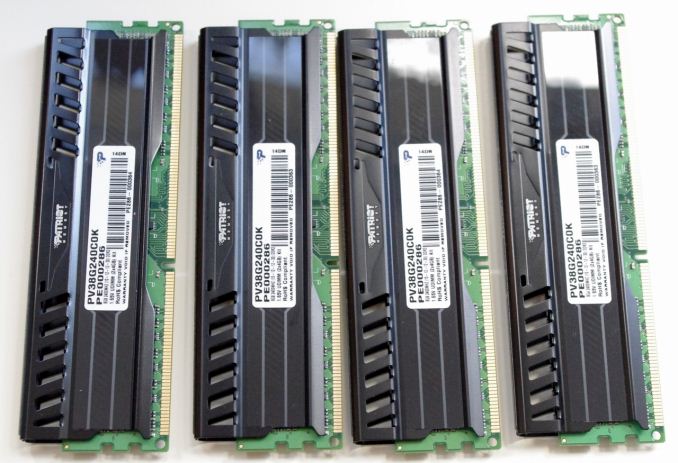
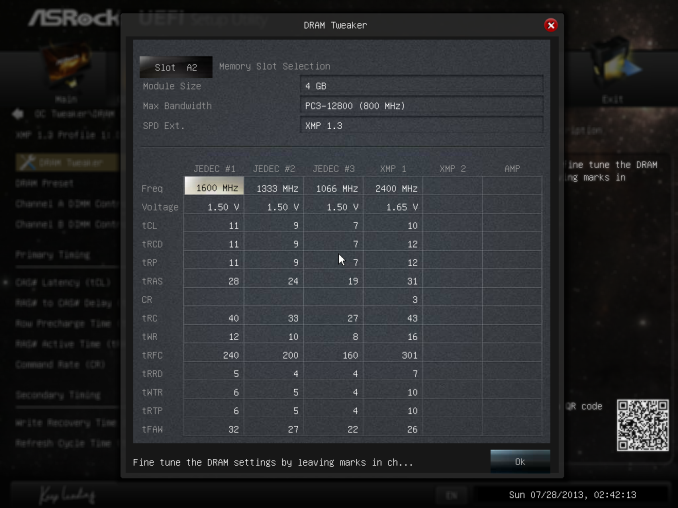
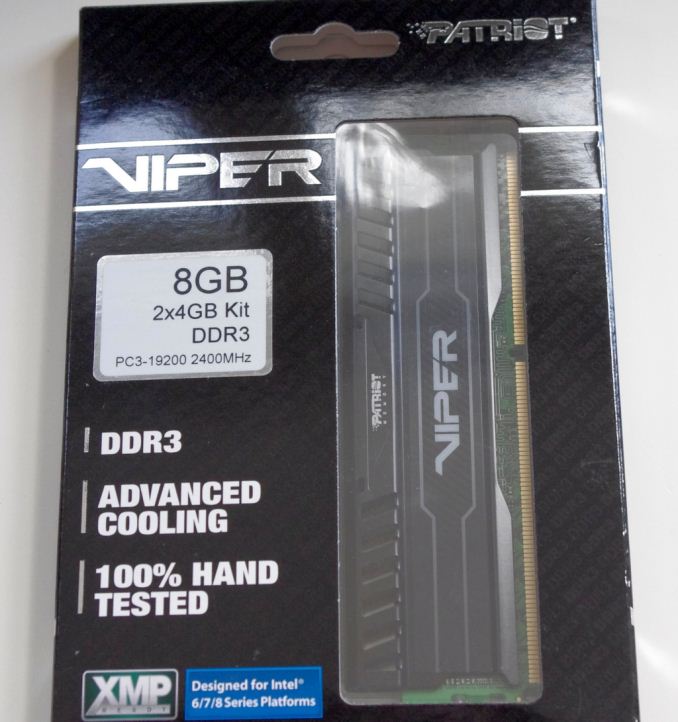
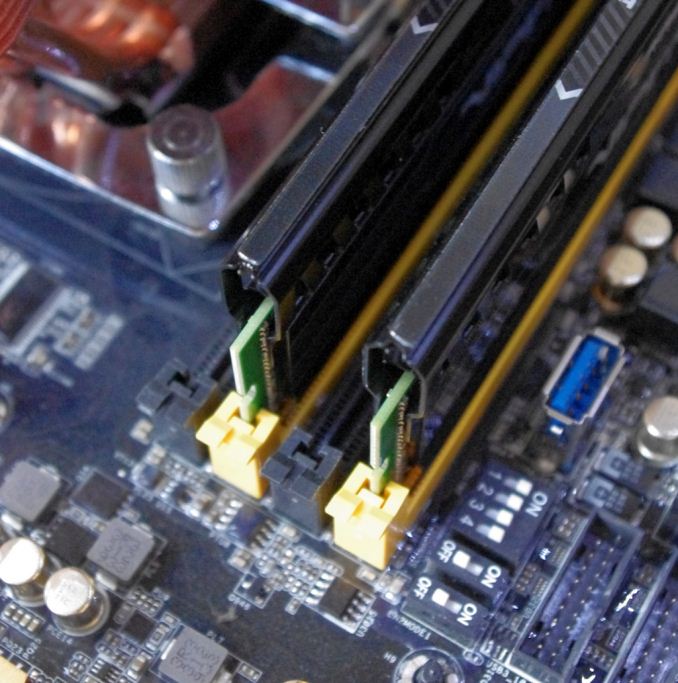

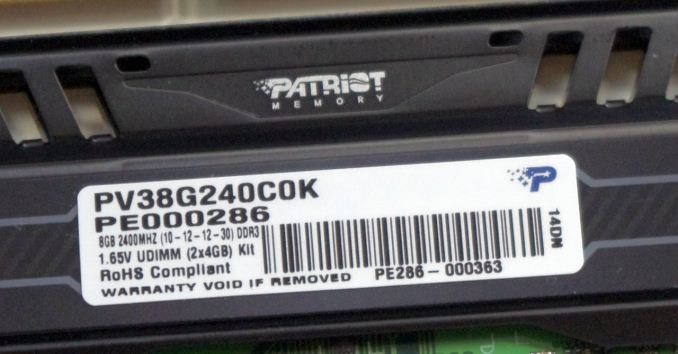














48 Comments
View All Comments
mfenn - Tuesday, November 19, 2013 - link
Expanding upon this point: the data in Anandtech articles is always top notch, but it is becoming more and more obvious that there are two tiers of reviewers when it comes to delivering insight. Anand, Brian, Ryan, and Jarred write good conclusions based on their data and don't care about any blowback from the manufacturers. Dustin and Ian seem beholden to the manufacturer's PR departments and just parrot whatever talking points they're given. It's really disappointing.Gen-An - Tuesday, November 19, 2013 - link
And who exactly do you think is going to be interested in a kit like this, other than overclockers? The review fit the product and the target audience. It's not for general users, never will be, and doesn't need to be reviewed as if it were.Gen-An - Monday, November 18, 2013 - link
Patriot has changed the ICs on this kit without changing the SKU. I have two of the 2x4GB kits that only have 8 chips on a single side of the PCB and none on the other, and use Hynix H5TQ4G83MFR 4Gbit ICs (the same ones that are on those DDR3-3000+ kits) and clock accordingly. One kit I bought but took back was like these in the review, double-sided sticks with 16 chips per stick (8 per side) and using a relatively new IC, Hynix H5TQ2G83DFR, which can't clock as high as H5TQ2G83CFR unfortunately.IanCutress - Monday, November 18, 2013 - link
With the demand for MFR seemingly strong, and other companies other than Patriot going after 2400MHz and up, I guess going to CFR was more a financial choice.Companies seem rather reluctant to tell me which ICs they use, and popping a heatspreader off is no mean feat nowadays, with accidents happening regularly: http://forum.hwbot.org/showpost.php?p=207472&p...
That's compounded by the fact that sometimes the IC # is removed and replaced with the company name over and over. Any suggestions?
Gen-An - Tuesday, November 19, 2013 - link
CFR would have been preferable to DFR, which as you review and this one show, doesn't like going higher than 2600: http://www.techstation.it/articoli/patriot-viper-i...chekk42 - Monday, November 18, 2013 - link
Ian, whatever happened to low latencies? I'm currently running a 1600MHz CL7 kit which I bought 2+ years ago, but I only ever see CL9 (and up) kits in reviews or for sale these days.joos2000 - Monday, November 18, 2013 - link
Lower latencies doesn't yield the same performance returns as upping the clock frequencies, that's why.http://www.anandtech.com/show/7364/memory-scaling-...
ShieTar - Tuesday, November 19, 2013 - link
The reason is that defining latency as a multiple of clocks is rather silly with a large range of clock speeds available concurrently. What your CL7 means is that you have a latency of 4.38 ns (7/1600MHz). The fastest latencies in other clockings available are:1066 CL7 => 6.56 ns
1333 CL7 => 5.25 ns
1600 CL6 => 3.75 ns (But only on 2GB kits)
1866 CL8 => 4.29 ns
2133 CL9 => 4.22 ns
2400 CL9 => 3.75 ns
2666 CL10 => 3.75 ns
2800 CL11 => 3.93 ns
3000 CL11 => 3.67 ns
So as a matter of fact, all kits tested in this review, except for the ADATA ones, have shorter latencies than your own set.
Gigaplex - Tuesday, November 19, 2013 - link
You missed the part where they asked for low latency 1600 and you quoted a 1600 at CL6 without saying where it's from. Like they said, most 1600 kits come at around CL9 which is around 5.63ns. This matters somewhat when Intel CPUs such as the i7 4770K are rated at 1600, any higher and you're running out of spec.ShieTar - Tuesday, November 19, 2013 - link
Not sure how I "missed" that, it doesn't say anything about a 1600 kit at CL9 in the question :" I only ever see CL9 (and up) kits in reviews "
Well, most kits in reviews and announced sales are probably not 1600 at this point in time. In the review above you see 5 kits at 2400+, with only a single 1600 kit thrown in for completeness. So I assumed that the original poster was expecting DDR3 2400 to also come with CL7. Sorry if that assumption was incorrect.
The quoted CL6 kits are "OCZ Reaper HPC Edition" (OCZ3RPR1600C6LV4GK) and "Super Talent Chrome Series" (WB160UX6G6). I think both are actually discontinued, because you can buy a 2400 CL9 set and just run it at 1600 CL6. As shown above, you could even buy a 2400 CL10 set and get a little lucky and still run it at 1600 CL6 (same latency as the tested 1866 CL7)
So sure, DDR3 1600 kits are rarely sold with very low latencies today, that's because low-latency kits are validated and sold at higher frequencies. This does not matter very much, since all kits come with a JEDEC setting to run 1600 initially, and everybody who knows he needs better latencies can lower them by hand to the actual achievable latency. Kits sold as 1600 are really mainly for people looking for cheap memory. Which is fine, as most reviews show little to no relevant gain from faster memory for most tasks anyways.